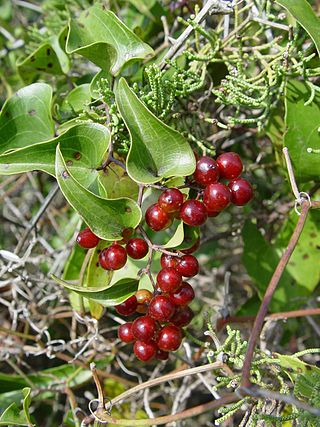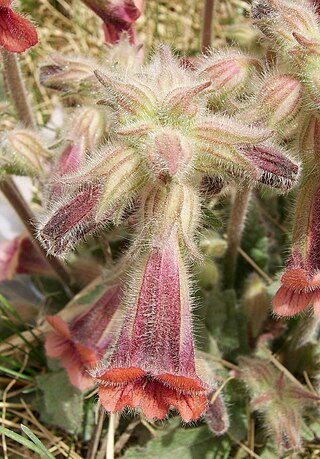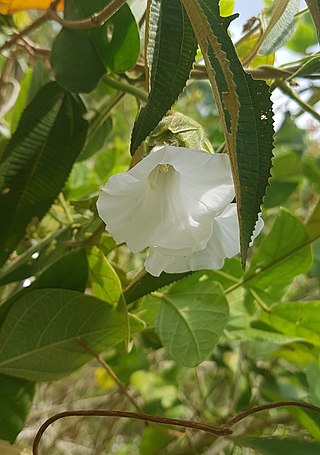
Smilax is a genus of about 300–350 species, found in the tropics and subtropics worldwide. They are climbing flowering plants, many of which are woody and/or thorny, in the monocotyledon family Smilacaceae, native throughout the tropical and subtropical regions of the world. Common names include catbriers, greenbriers, prickly-ivys and smilaxes. Sarsaparilla is a name used specifically for the Neotropical S. ornata as well as a catch-all term in particular for American species. Occasionally, the non-woody species such as the smooth herbaceous greenbrier are separated as genus Nemexia; they are commonly known by the rather ambiguous name carrion flowers.

The Caprifoliaceae or honeysuckle family is a clade of dicotyledonous flowering plants consisting of about 860 species, in 33, to 42 genera, with a nearly cosmopolitan distribution. Centres of diversity are found in eastern North America and eastern Asia, while they are absent in tropical and southern Africa.

In the botanical classification of plants, Aeridinae Pfitzer is a subtribe of the tribe Vandeae whose representatives all have a monopodial growth habit and do not possess pseudobulbs.

Clarke Abel was a British surgeon and naturalist. The standard author abbreviation C. Abel is used to indicate this person as the author when citing a botanical name.

Rehmannia is a genus of seven species of flowering plants in the order Lamiales and family Orobanchaceae, endemic to China. It has been placed as the only member of the monotypic tribe Rehmannieae, but molecular phylogenetic studies suggest that it forms a clade with Triaenophora. Contrary to the immense majority of the taxa of Orobanchaceae, Rehmannia is not parasitic.

Maianthemum includes the former genus Smilacina and is a genus of perennial herbaceous flowering plants with fleshy, persistent rhizomes. It is widespread across much of North America, Europe and Asia, and may be terrestrial, aquatic or epiphytic. It is characterized by simple, unbranched stems that are upright, leaning or hanging down and have 2–17 foliage leaves. Leaves are simple and may clasp the stem or be short-petiolate. The inflorescence is terminal and either a panicle or a raceme with few to many pedicelate flowers. Most species have 6 tepals and 6 stamens; a few have parts in 4s. Tepals are distinct in most species and all of similar size. Flowers are spreading, cup-shaped or bell-shaped and usually white, but lavender to red or green in some species. Fruits are rounded to lobed berries containing few to several seeds.

Iresine is a genus of flowering plants in the family Amaranthaceae. It contains 20 to 25 species, all of which are native to the American tropics. The generic name is derived from the Greek word εριος (erios), meaning "wooly", referring to the trichome-covered flowers. Bloodleaf is a common name for those species that have colored foliage, and these are often cultivated as ornamental plants. Some species are additives to versions of the hallucinogenic drink ayahuasca.

Woodwardia is a genus of ferns in the family Blechnaceae, in the suborder Aspleniineae of the order Polypodiales. Species are known as netted-chain ferns. The genus is native to warm temperate and subtropical regions of the Northern Hemisphere. They are large ferns, with fronds growing to 50–300 cm long depending on the species. The fossil record of the genus extends to the Paleocene.

Linnaea is a plant genus in the honeysuckle family Caprifoliaceae. Until 2013, the genus included a single species, Linnaea borealis. In 2013, on the basis of molecular phylogenetic evidence, the genus was expanded to include species formerly placed in Abelia, Diabelia, Dipelta, Kolkwitzia and Vesalea. However, this is rejected by the majority of subsequent scientific literature and flora.

Tournefortia, often called soldierbushes, is a genus of flowering plants in the borage family, Boraginaceae.

Spermacoce or false buttonweed is a genus of flowering plants in the family Rubiaceae. It comprises about 275 species found throughout the tropics and subtropics. Its highest diversity is found in the Americas, followed by Africa, Australia and Asia.
Henri Guillaume Galeotti was a French-Belgian botanist and geologist of Italian parentage born in Paris. He specialized in the study of the family Cactaceae.

Martin Martens was a Belgian botanist and chemist born in Maastricht, Netherlands.

Vesalea floribunda, also known as Mexican abelia, is a species of flowering plant in the honeysuckle family, Caprifoliaceae. It is a shrub native to southern Mexico, ranging from central Veracruz to northern Oaxaca and southeastern Chiapas.

Quercus insignis is a Mesoamerican species of oak in the white oak section, within the beech family. It is native to southern Mexico and Central America, from Veracruz to Panamá.
Gyrandra is a genus of flowering plants in the family Gentianaceae, found in Texas, Mexico and Central America. Annual herbs, they are usually found in montane pine-oak forests.

Argyrochosma formosa is a fern known from eastern and central Mexico and Guatemala. It grows on rocky slopes, particularly on limestone. Unlike many members of the genus, it lacks white powder on the underside of its leaves. First described as a species in 1842, it was transferred to the new genus Argyrochosma in 1987, recognizing their distinctness from the "cloak ferns".

Lamourouxia is a genus of flowering plants belonging to the family Orobanchaceae.
Seymeria is a genus of flowering plants belonging to the family Orobanchaceae.

Odonellia is a genus of flowering plants belonging to the family Convolvulaceae.

















